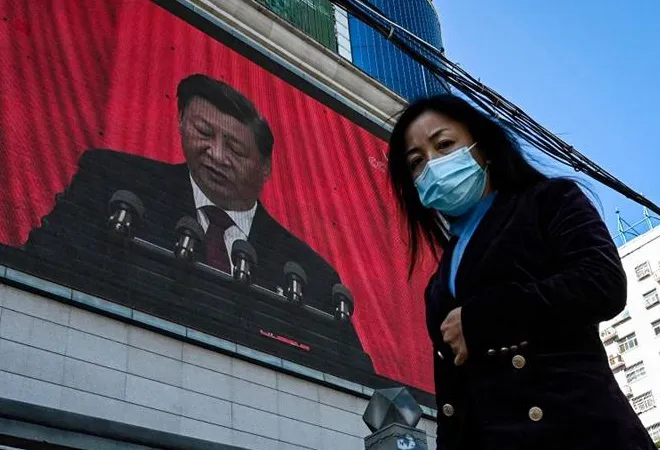
In the past weeks, as COVID-19 has again reared its ugly head in China, the rest of the world is exercising caution to avoid another global spread of infections. Most countries have been able to contain the virus but China’s continued battle with COVID-19 despite its coercive measures compels one to ask whether China’s authoritarian system is jeopardising its struggle against the pandemic.
It is common knowledge that China is way ahead of India in terms of all indicators of development. Even though the two countries were very close to each other till the 1970s, or even in some respects till the beginning of the 1980s, China’s growth in the next three decades was so fast and globally recognised as phenomenal, that India was left in the dust. It was true for both economic and human development indicators as well. Some key health indicators reveal that the number of physicians per 10,000 people was 14 in China to India’s 6 and hospital beds per 10,000 people was 30 in China in comparison to India’s 5. Yet, India, with a democratic system, has been able to arrest COVID-19 infections to a large extent.
China’s authoritarian model and lack of transparency
Despite being so much advanced in its development story, China is in deep trouble with its ‘zero COVID’ policy while the rest of the world including India has normalised after lifting most, if not all, COVID restrictions? First, the causality of China’s authoritarian system has been free flow of data on the COVID-19 infection and deaths. Despite China being the first country to encounter massive waves of COVID-19, till 10 December 2022 China reported 1.86 million cumulative number of confirmed cases which is quite low in comparison to other countries. In terms of per million people, this comes to 1,307.77, whereas for India, per million confirmed cases for the same period were 31,524.76. Cumulative confirmed deaths in China due to COVID-19 till 10 December 2022 stand at 5,235 to India’s 530,658; that is, China’s per million reported deaths stand at 3.67 to India’s 374.45 The contrast is even starker when we think of China and the United States (UK)or China and the United Kingdom (UK).
In the initial phase of the pandemic, the World Health Organisation (WHO)-China Joint Mission in its report patted China (February 2020) putting its stamp of approval on China’s method of arresting the COVID-19 cases across the country. China ended 2020 on a high note telling the world that it had largely won the war against the virus and claimed superiority of its political model to Western democracy. Sadly, now the chicken has come home to roost. The success story is now up in smoke and China could face the grim reality of a massive resurgence of the pandemic. Yet there is no way China can go back to its now infamous ‘zero-COVID’ policy as massive street protests against it have even dented President Xi’s authority who preferred to soft pedal the issue by reportedly describing the protests, in his conversations with EU President Charles Michel, as the work of students “frustrated” by three years of the pandemic.
Taking silence and public compliance as sign of success, it prematurely declared victory of authoritarianism over democracy.
The journal, Science, in a paper analysing the WHO-China Joint Commission Report, laid bare the bizarre COVID restrictions enforcement strategy and argued that China’s ways of securing citizen compliance to stringent restrictions are unworkable in other countries. ‘Nor should they’, argued lawyer Alexandra Phelan, a China specialist at Georgetown's Center for Global Health Science and Security. “Whether it works is not the only measure of whether something is a good public health control measure,” Phelan said. “There are plenty of things that would work to stop an outbreak that we would consider abhorrent in a just and free society”. China not only followed the stringent ‘zero-COVID’ policy; to make it look successful, it imposed severe controls on the expression of any opinion or information different from what the government dished out by silencing the state-controlled press and censoring social media. Taking silence and public compliance as sign of success, it prematurely declared victory of authoritarianism over democracy.
However, this was no surprise. Authoritarian systems are always quicker and more efficient than democratic systems as multi-layered accountable governance procedures in democracy might initially appear faltering, indecisive and target of incisive public criticism. But authoritarian success is said to be always short run; in the long-term democracy supposedly achieves more. This Aristotelian wisdom has again found confirmation in our pandemic experience. This explains why India today is in a much better position vis-à-vis the virus than China.
Working of democratic accountability in India
It is undeniably true that India has faced multiple hiccups and challenges of governance since the outbreak of the pandemic. But, its various institutions of accountability like its federal structure with multiple parties in power in different states, vigilant media, independent judiciary and civil society have created conducive conditions for governments, both at the Centre and in the states, to engage in constant course correction and deliver services to the people in the wake of the pandemic. Though the Indian state has of late sometimes been accused of being highhanded with regard to freedom of expression; however, in the face of the pandemic, an unknown and super-destructive enemy, the government thought it wiser to avoid infringing upon fundamental democratic freedoms unless absolutely necessary. The result was an active media-print, television and digital, which started taking the government, both central and state, to task for every misstep, for policies costing the people, policy confusion and evasiveness. Doubtless, it was a great source of uneasiness as well as learning for the governments.
The sudden declaration of national lockdown in March 2020 by the Centre and the extreme hardship that it caused to the public, especially to the massive number of migrant workers, was severely criticised by the press and also came under judicial scrutiny. By May 2020, the Centre, under pressure from the states started to concede authority to the states with regard to containment zones and opening up for economic activity. In some media reports, the issue of constitutionality of the Centre’s bypassing the authority of the states with regard to health by using the Disaster Management Act, was also raised. In the face of criticism, especially by states ruled by Opposition parties, regarding lack of financial assistance and GST compensation to the states, the Centre agreed to transfer funds to the tune of INR17,000 cr to the states in April 2020 and launched the Atmanirbhar COVID-19 relief package. However, the issue of fund transfer to states remained a major bone of federal contention throughout the critical period of the pandemic. Also, the point repetitively made by the experts on cash transfers to the poor pushed Centre and several states to initiate cash transfer schemes to assist vulnerable sections who were facing acute livelihood crisis during the pandemic. Even the Supreme Court intervened, in the middle of the second wave, to tell the states not to insist on identity cards for free delivery of rations and also to provide for food and transport for stranded migrant workers.
The lesson for India, of course, is that democratic values must never be compromised for any near-term benefit.
During the second wave of the pandemic, the Centre’s mishandling of the oxygen crisis and unpreparedness in many states for healthcare facilities and cautionary measures facedheavy criticism from all quarters including the opposition, media, experts, judiciary and international community. The Supreme Court and many high courts heard pleas relating to oxygen crisis, paucity of hospital beds and anti-viral drugs and gave instructions to the governments to mitigate the issues. The shocking inefficiency in handling cremation of dead bodies in some states was there for all to see on their television screens and social media sites, reported by a vigilant media and sections of vocal citizenry. When vaccines became available, their distribution and pricing became issues of contention between the Centre and the states and here too, the Centre conceded to the demands of the states which was largely supported by the media and the public generally.
Democratic accountability delivers over authoritarian coercion
These are some instances which show how the Central and state governments were exposed to media and public criticism and tried to mend their ways accordingly which has allowed India a soft landing vis-à-vis the pandemic. None of these was possible in authoritarian China which is why it has landed itself in a deep crisis today. The lesson for India, of course, is that democratic values must never be compromised for any near-term benefit. But China’s unraveling and upcoming COVID-19 crisis is less a moment for damning authoritarianism than for raising buffers to stem another global surge of the pandemic. For today’s reality is, to paraphrase 19th century Austrian Chancellor Prince Metternich, when China sneezes, the rest of the world catches a cold.
The views expressed above belong to the author(s). ORF research and analyses now available on Telegram! Click here to access our curated content — blogs, longforms and interviews.




 PREV
PREV



